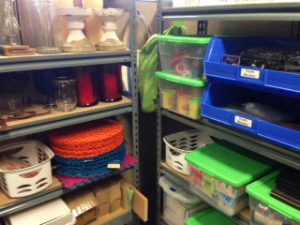
We’ve been doing a lot of “spring cleaning” in our offices lately. This task was initiated by the fact our office space has been re-designed which happens to coincide with the fact it is now spring here in St. Louis. Regardless, all of National Mission has been rolling up our sleeves to eliminate some clutter during this move. More specifically, we’ve been tasked to deal with the rows and rows of file cabinets, shelves of books, extra supplies and other items. At first glance, this seemed like a daunting task. LCMS Youth Ministry has 30+ years of saved documents in these drawers, a resource library, “extras” from previous LCMS Youth Gathering and more. So, how does one go about ‘spring cleaning’ while still holding onto important information and honoring past treasures? Here are some guidelines we followed.
- Enjoy the process. In her book, The Secrets of Simplicity, Mary Carlomagno shares a step-by-step “path” to “learn to live better with less”. This guide, first recommended to me in a leadership class, has been helpful for me in understanding and attempting the process of “spring cleaning” in our office. It has also helped me realize the importance of creating a work environment that allows me to focus on my priorities instead of the piles of paper and other items and know this will always be a work in progress.
- When in doubt, throw it out. This was the mantra Bart Day, Office of National Mission Executive Director, exclaimed when we were tasked with the job. Unsure of what a document or file is even referring to? Probably means you haven’t been dashing back to read through it over the more recent past. Take a deep breath, and then recycle it.
- The scanner is your friend. There are some documents worth keeping. These might be of historical significance or be connected to events that are scheduled on a regular basis. Scan what might be needed for future reference and recycle the originals.
- Touch it once. Whether it is a document, a book, or a treasured item, try to only touch the item once when making your decision on whether to keep, recycle, scan, or repurpose.
- Donate the extras. During the “spring cleaning” process everyone soon discovered “extra” items they were not using. We designated a donate space for the extra books, office supplies, and many miscellaneous items no longer needed. Books were boxed and donated for the local libraries book sale. Extra items were donated to a local teacher recycling center. Occasionally someone was looking for an item for their use and discovered just what they needed in the donate space.
- Develop a plan to prevent future “clutter”. Once you have downsized or emptied a file drawer determine how long you need to keep what remains. An example is our periodical library. We determined how many back issues are needed and when the latest issue is added the oldest issue is moved to recycling.
- Keep the process going. After the big task of cleaning, sorting, clearing and scanning is complete, keep the process going. Determine what you will need for future reference and make it a priority to regularly (daily, weekly, monthly) review and recycle what won’t be needed. The end result can be a time when “spring cleaning” is no longer necessary because the process is happening in every season.